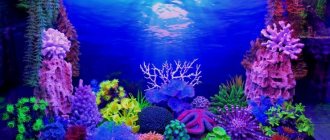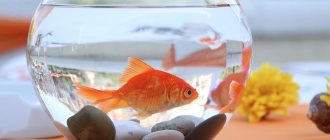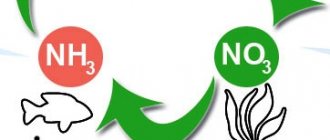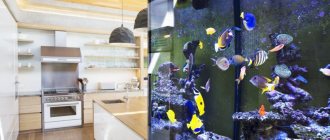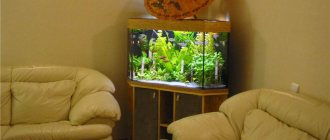The idea of organizing a “flow”, namely the constant replacement of old water with new water in a marine aquarium, arose a long time ago. There are technological difficulties: mixing sea water and storing it, or dosing salt with some complex device into distilled water with constant control of salinity. This all seems very complicated and not very clear - but is it necessary at all? To understand this, I will retell, and in some places quote, Randy Holmes-Farley’s article “Water Changes in Reef Aquaria” published in the online magazine Reefkeeping. The original article can be read, or better yet, “must read,” here.
So, what do we mean by water change? This is the process of replacing some of the “old” water from the aquarium with “new”, freshly prepared water. It is assumed that the “new” water is prepared on the basis of either distillate or osmolate and dissolving sea salt in it for an aquarium from a trusted manufacturer to a salinity of 35 ppm. That is, we assume that the new water contains only those elements that are needed in the required proportions by the marine animals living in the aquarium. How often to do water changes and what volumes to change is a matter of almost a holy war among aquarists. Some people don't change the water at all. Some people change significant volumes of water regularly. There is an opinion that you can simply add traces to the aquarium and remove unwanted substances from the water using sorbents or other export methods.
River in... apartment. Why is this necessary?
Any aquarium is a closed system with more or less stable water parameters and a certain number of living inhabitants that actively feed and grow.
Under such conditions, the system loses its stability: decomposition products and organic matter accumulate, and various organisms develop. As a result, the aquarist gets a complex that can quite rightly be called in one word: a swamp. To prevent this from happening, the water must be changed. The frequency and volume of replacement depends directly on the number of aquatic organisms living in the aquarium and the total volume of the home reservoir. Very often, an aquarist is dealing with limited volumes of water and living space, while the desire to have more animals is humanly understandable. In cases of breeding productive fish, the lack of “space” becomes a very noticeable matter.
In addition to the fact that regular water changes dilute organic matter and salts, wash away toxins, etc. — fresh water contains microelements necessary for the growth of aquatic organisms, which are already depleted in old water. Changing water partially solves the problem of preventing diseases and the poisonous effect of certain substances and formations incompatible with life.
On the other hand, fish and plants are quite sensitive to sudden changes in the chemical composition of water.
For example, some particularly sensitive plants, with large one-time changes, may lose some of their leaves, and in some cases die.
The same applies to fish. For this reason, an amateur who changes 50 percent or more of the water in a very short period of time makes a big mistake, the consequences of which may not be correctable.
A running water system in an aquarium quite effectively solves these and many other problems. If your farm contains a large number of fish, this note is for you. It is also worth mentioning that cleaning the bottom of the aquarium should be done in the same mode as before.
The duct cannot cope with this.
The running water system consists of the following components:
- Supply and drain pipes, fittings and fastenings.
- Water pre-treatment system (hereinafter referred to as PPV).
When installing the system, you must be guided by the principles of system safety! Pay special attention to the fastening and quality of the materials used. Any malfunction can lead to flooding for you and your neighbors, which will entail rather disastrous proceedings and penalties. Below I will describe my system in more detail, where the main criteria when choosing the components of this system was security. I highly recommend paying special attention to this.
Description
'Flow' is a system of constant or periodic water renewal. All flow systems provide for draining water into the sewer and adding new water from the water supply. What does this give? First of all, it eliminates the need to manually change the water.
The duct has many disadvantages, mainly technical. However, sometimes it's great to eliminate the need for periodic water changes. Especially in cases where large fish like discus live in the aquarium, which eat abundantly and pollute the water, but at the same time require clean water. If you are planning an aquarium and realize that massive daily changes await you, you cannot do without a channel.
Features of water intake.
Water in main pipelines has certain features that are worth talking about separately. In addition, you need to decide whether you will use PPV, or whether water will be supplied to the aquariums directly.
- The pressure in the pipes is regulated at the central heating station by pumps (so-called pumping). Basically, these are automatic electronic systems that maintain a certain pressure in the pipes. It should be. In fact, the pressure in the pipes is constantly “jumping”. Even when you turn on the tap in your kitchen, the pressure drops rapidly. There are various devices for measuring pressure. One of which is called a pressure gauge. The price is about 350 rubles (hereinafter prices in Novosibirsk are indicated for July 2005). More expensive pressure measurement systems are able to take measurements without directly connecting to the system. Why am I paying so much attention to this? The fact is that most accidents occur precisely during sudden upward pressure surges. When performing installation, you must be aware that the system must have a certain margin of safety.
- Water parameters can also fluctuate. In general, a person only knows that the water is drinkable. This is clearly not enough for use in an aquarium. You can conduct your own water tests by making the necessary measurements, or get them from a local laboratory for a set fee. We set the required water values in the PPV using well-known methods. Sometimes when water settles you can see sediment at the bottom. This shouldn't be surprising. Huge amounts of rust and suspended particles are common in our main pipelines. To eliminate this situation, we use PPV.
- One of the essential components of our drinking water is chlorine, chloramine, etc. This is done for reasons of safety for human health. This is not good for the inhabitants of the aquarium. However, there are some nuances here. Firstly, fresh water is not supplied to the aquarium so quickly as to cause damage to the fish from this side. Secondly, there is a technical means to reduce the effect of chlorine and accelerate its neutralization, which will be discussed later. In addition, there is a chemical way to eliminate chlorine.
- Temperature. We will draw from cold water, this should not be scary. In any case, the water intake and the aquarium will be at some distance, therefore the water will be a little warmer. Mixing occurs in the aquarium and the temperature equalizes. To maintain a high temperature in a specific aquarium, for example, a spawning tank, we use a conventional heater with a thermostat. If there is a need to maintain a given temperature in all aquariums at once, the heater is installed in the PPV. In addition, fish in nature encounter different temperature regions. For example, at depth the water naturally warms up less. I often notice that my fish sometimes stand for a long time at the water supply point - apparently they like it. I haven’t had any illnesses or deaths (ugh, ugh, ugh) for a long time. In part, I associate this fact with the duct.
Sometimes authors writing about ducts recommend feeding inside the drain. In my opinion, this is fundamentally wrong.
Firstly, it is impossible to notice a leak in the supply in a timely manner, and later it is quite problematic to eliminate it. Secondly, there is a very strong narrowing of the working diameter of the drain. The feed also has its own diameter, and it is very noticeable. Thirdly, if you are making a system with rubber hoses, an accidental kink in the supply inside the drain will most likely break the hose.
It’s good if someone is at home at this time. And if not?
If you agree with my idea of metal-plastic, such a solution is simply not technically feasible.
Automatic water heater
The vast majority of aquarium fish with bright colors and lush fins, which are so valued in aesthetic terms, come from the tropics. To live normally, they need warm water, often within a certain temperature range. For this purpose, there are special heaters that maintain the water temperature accurate to a given degree. There are three types of devices:
- bottom, buried in the ground and having a beneficial effect on vegetation;
- external flow-through systems installed outside the aquarium;
- submersible, lowered into water to a certain depth.
The main thing is to choose equipment of suitable power; usually, for a container with a volume of 100 liters, an installation of no more than 100 W is suitable.
It is better to immediately purchase a high-quality water heater that can last for a long time. Cheaper options are often prone to breakdowns, either breaking down completely or making the water too hot or cold. This can cost your pets their lives, so to monitor the operation of the heater you need to purchase a thermometer. The most convenient option is a strip with a mercury level that is glued to the wall of the aquarium.
Selection of components.
The first system I made was based on ordinary rubber hoses. The supply hose was purchased at a nearby pharmacy. The price for it now is 1m - 7 rubles.
The drain hose is a regular garden hose, sold in hardware stores. Price 1m - 15 rubles. The necessary fittings are sold in hardware stores and on the market. They are significantly cheaper than the described system. I will not list a number of disadvantages of such a system; they will be clear from further explanations.
Now I have a system using metal-plastic pipes. This system has a number of advantages:
- These pipes are designed for high pressure, which simply does not exist when used in a duct. That is, the safety margin is very large.
- Metal-plastic is easy to give the desired shape, which is perfectly preserved. This is especially important when draining, where it is necessary to avoid sharp corners and especially clamps. This is more difficult to achieve with rubber hoses.
- To install the system, you only need two adjustable wrenches, a knife, a screwdriver, a hacksaw, fiber flax, or another sealant.
- For fastening to walls, special clamps are sold that “deadly” hold the pipe. They come in plastic and metal, the latter being of course preferable.
- Metal-plastic is used for working with drinking water and does not release harmful components into the water.
- All connections are of high quality and do not leak. Of course, this can be achieved with rubber, but no matter what you attach to the rubber, it will still remain rubber.
- The appearance is more stylish and cannot be compared with rubber. Not even close. Even at night.
Disadvantages of metal-plastic.
- The pipe itself is relatively inexpensive. For example, a 16mm pipe, critical temperature +60, costs 15 rubles. But the fittings will cost more than for a system made of rubber hoses. Much more expensive.
- At fittings, the working diameter narrows. Although, if you take into account the fact that to clean the system you need to start with them, this provision can be interpreted as a plus of this system. The pipes themselves can be successfully cleaned under high pressure; to do this, just connect the supply to the drain and open the tap more.
- While researching sites dedicated to metal-plastic, it turned out that over time the pipe is susceptible to delamination. True, we must take into account the fact that we are talking about a pipe operating at maximum pressure. We practically don’t have it in our aquarium. In addition, at a low price of the pipe, it can always be replaced. The fittings are dismountable; they will have to be changed extremely rarely, if at all.
The choice of materials is yours. Next I will describe my system in detail, but with a small discount you can rewrite it for rubber. Nothing will change fundamentally.
Drip duct
Sometimes changing a large amount of water is not desirable. For example, when creating biotopes rich in humic acids. Or in a planted aquarium. In this case, the so-called drip flow is used: water enters the aquarium in a thin stream or even barely drips.
For example, in an aquarium with a volume of 200 liters, it is necessary to change 50% per week. It turns out that you need to replace 100 liters per week or 100/7/24
=0.6 liters per hour. When setting up the flow, you can measure both how long it takes to fill a container of a known volume, and how much water will be poured into a separate container after topping up, for a certain time.
Water supply.
Technically, water intake can be done in several ways.
1 way. We remove the mixer in the bathroom or kitchen along with the eccentrics. We screw in the tee for cold water and the straight pipe for hot water. We install the mixer in place. We screw a 1/2-inch diameter tap into the tee. Sometimes washing machines are connected this way.
Method 2. Unscrew the hose to the flush tank. We install the coupling and tee. Next, we use one thread of the tee for the hose on the tank. We screw a faucet into the other to supply water to the aquarium.
For rough water purification, you can use a 1/2 inch filter. Which is screwed in front of the supply tap. Sometimes such filters are installed immediately after the apartment inlet valves, which is more practical. The filter itself is a pipe with threaded connections and a metal mesh inside, access to which is through a screw-on nut.
Next, we run a metal-plastic pipe from the supply tap to the aquariums. For branching we use tees with three crimp nuts.
When installing, remember that:
- The pipe can be tapped into the wall.
- To reduce the laying distance, we drill holes in the walls.
- If the pipe will pass through an open area, you can make it yourself or order a decorative box. Masking pipes one way or another will require some imagination.
At each source we install a tap that regulates the water supply speed. We don’t put it in just one distant aquarium. Or, if the levels are different, we do not place the faucet at a higher level. An open water outlet is necessary so as not to create pressure in the hoses. Although, as I already said, excess pressure will do nothing to these pipes. Just in case.
With an intensive water supply, you can completely abandon the use of taps at the sources. With the same diameters of the outgoing pipe and a sufficiently high water pressure, the distribution will be uniform even without them.
In order to partially saturate the water with oxygen and evaporate chlorine, along the entire length of the aquarium we install a groove made from the same pipe, cut along the entire length and slightly turned out. It is necessary that the jet be in contact with air as much as possible. It is advisable to set the distance from the fall of the jet to the water level in the aquarium to at least 5 cm.
We attach the pipe to the walls.
Duct options
There are many flow schemes using valves, water level sensors and other technical devices. It is important to remember that the more active components there are in a system, the higher the likelihood of failure. Therefore, we will consider only reliable and proven methods.
Classical
There are two pipes connected to the aquarium: water and sewerage. Water is added to the aquarium, and the excess is drained by gravity into the sewer. The water level will be constant, at the drain level.
If the aquarium is really large or there are several of them, and the water top-up pipe is used at full capacity, the diameter of the drain pipe should be approximately 3 times larger than the diameter of the top-up pipe. If water is added in a thin stream, the so-called drip feed, you can drain and top up through pipes of the same diameter. In any case, you should not use pipes with an internal diameter of less than 16 mm for draining.
If the flow is planned during repairs, water supply and sewerage are simply connected to the aquarium. If no repairs are planned, water and sewerage are supplied using metal-plastic pipes or garden hoses. The nature of the pipes does not matter - the main thing is that they can withstand pressure and can be used for drinking water or food products.
When supplying water to the aquarium, it is worth considering the issue of adjusting the topping speed. The fact is that if you connect the adjustment tap near the connection point to the water supply, away from the aquarium, then in order to adjust the amount of water entering the aquarium, you will have to go from the aquarium to the tap and back several times. For this purpose, needle valves designed for high pressure are used. Ball valves are not designed for fine adjustment. If you are afraid that the cold water supply to the aquarium may not withstand the pressure, you need to install a reducer at the point of connection to the water supply.
To prevent clogging of the drain, the inlet hole is covered with a fine plastic or metal mesh or sponge. The larger the outer area of such a mesh, the less likely it is to suddenly become clogged.
Draining and refilling through one thin hose
With this flow pattern, draining and refilling are carried out through one hose. In this case, you can even use a thin air supply hose, which can be easily laid under baseboards and above doors. Switching the topping or draining mode is done using electronic timers or water sensors. For example, water can be drained using gravity due to the difference in water levels and the law of communicating vessels, and topping up occurs using a pump activated by a timer. A special feature of this method is the almost complete elimination of the possibility of clogging: even if the tube is clogged or aired, after turning on the top-up pump, the water will clear it.
In fact, what happens is not a flow, but automatic micro-water changes. The replacement cycle looks like this: using a pump, the required amount of water is supplied to the aquarium - accordingly, the water level in the aquarium rises. Then the pump turns off and the water begins to drain by gravity from the aquarium until the end of the tube located in the aquarium is in the air and the gravity of the water stops.
When designing such a duct, do not even think about connecting a thin hose directly to the water supply - it is not designed for such pressure.
Draining.
Let's start with installation to the existing sewer system. Again, there are many options here. It is possible to install a tee between the siphon and the common pipe; it is possible to drain into a specially added tee if you have a plastic sewer system, etc. This is where advice from a plumbing technician may be helpful.
Main:
- Since the water will drain by gravity, the drain and the pipe itself should go down and be below the levels of the aquarium. It is unacceptable to raise the pipe above these levels.
- Sharp corners and bends are unacceptable. We bend the pipe smoothly and securely fasten it in the same way as the feed.
- The diameter of the drain pipe should be significantly larger than the supply. For example, I have a feed of 16 mm, a drain of 32 mm.
The diameters themselves are selected from the total volume of your farm with a small margin. My need for flow at different times of the year is not the same, because... Both the aquariums themselves and the number of fish living in them change. The diameters indicated above cope with a volume of 1200 liters and 2500 fish of different ages. Like that. Fine adjustment and tuning of the system is carried out experimentally.
Draining water from aquariums can be done in several ways.
Option 1. The most successful way is to drain the water from the side hole of the aquarium, which is drilled at the top edge.
If you have no experience, entrust this procedure to a master. Independent actions can lead to the complete collapse of the aquarium, and possibly the desire to do anything in the future. As a drain, you can use a regular ball valve for a flush tank. You just need to enlarge the drain hole and pull a mesh over it to prevent small fish, snails and plants floating on the surface from getting into the drain. We install soft rubber gaskets on both sides and tighten them with locknuts.
Option 2. Making ballast tanks, attaching them to the side walls of the aquarium, or to the wall of the room. Overflow pipes can be made of the same material or made of glass. The end lowered into the aquarium must also be covered with a net. And if it is metal-plastic, you can flatten the end and drill a sufficient number of small holes along the pipe of 5-10 cm.
Option 3. Making a loop from the pipe itself. This is the easiest way. The pipe is bent gently, without angles, and a tee is attached to it, the middle of which is set at the same level as the level in the aquarium. The tee has crimp nuts on all sides, and the pipe underneath is rigidly attached to the wall.
The top tube is needed to bleed the drainage system and eliminate air pockets on the overflow. In addition, without it, all the water from the aquarium may end up in the drain.
The last two options are less desirable, because Air pockets will form in the overflow pipe and loop, which must be eliminated in time by blowing or filling with water. Air locks can cause apartment flooding, so you need to take this issue seriously.
To automatically remove plugs, containers with water are used, which are attached to the top point of the loop, where the air is replaced by water.
Ordinary plastic bottles or other available containers are used as a reservoir.
Adviсe
When designing a duct, imagine the situation if the electricity is turned off or the water is cut off. Try to determine the approximate amount of water that will flow into the aquarium. If the volume from the surface of the water to the top edge of the aquarium allows you to accommodate the amount of water entering the aquarium overnight or during the period when the owners are away from home, this can be a big help if something goes wrong with the drainage.
When draining through a hole in the bottom, use an overflow shaft to prevent all the water from draining from the aquarium. Learn how to make a sump drain.
Some modern water controllers allow the connection of water leakage sensors. In case they are triggered, you can either turn off the solenoid valve on the water supply or send a message.
When using solenoid valves, it is better to use valves that are closed when switched off. This will bring double benefits: in the event of a power outage, the water supply will stop, eliminating overflow, and it will also protect the aquarium from hypothermia in the cold season.
When using a needle tap, it makes sense to install a water filter in front of it, which will protect the valve from clogging.
Don't use overly complex solutions. For example, opening the drain and stopping the flow when the water level sensor is triggered. Besides the fact that such sensors are very unreliable, the more complex the system, the higher the chances that something will go wrong. Use sensors, controllers and relays only as an additional safety net.
Source
Refrigeration unit
Not all fish owners strive to acquire tropical inhabitants; there are also lovers of cold-water species that feel good at temperatures of 16-18 degrees Celsius. In such cases, what is needed is not a heater, but a refrigerator that maintains comfortable conditions for the inhabitants of the aquarium. The principle of its operation is the same as for a heater. The installation cools the water to a set value and then maintains the temperature constant. To do this, the device must have a reliable thermostat.
The system does not necessarily have to make the water very cold, as is required for freshwater species. Even more often, it is installed for expensive marine fish, which are generally heat-loving, but cannot survive at temperatures above 29 degrees.

